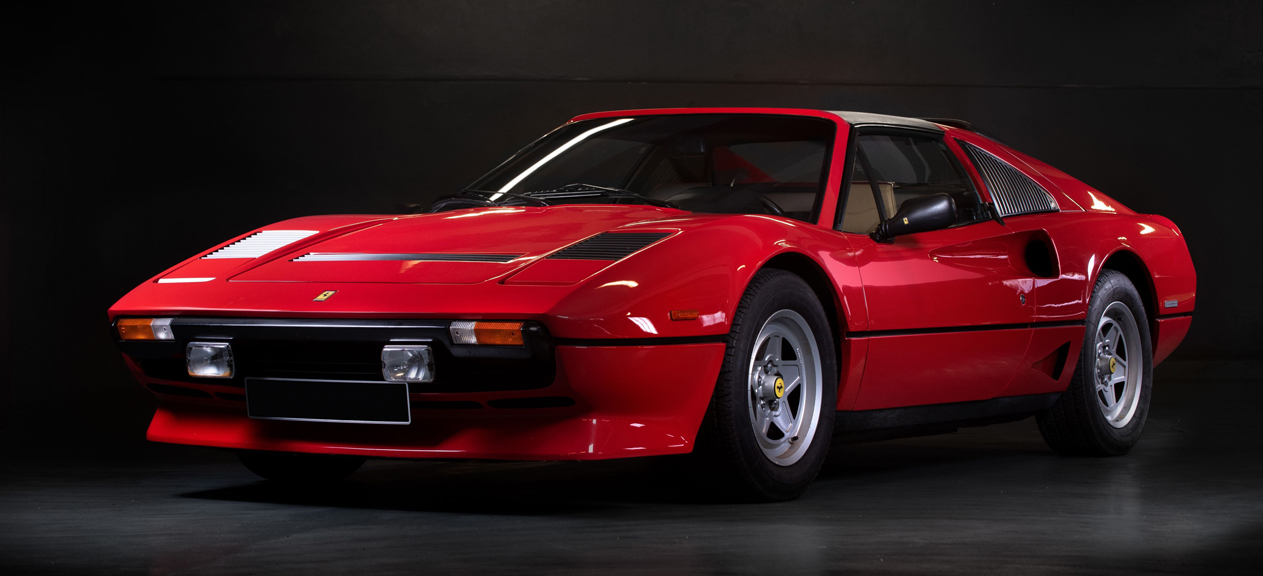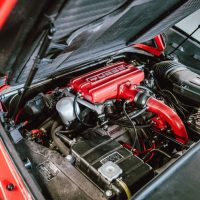SCM Analysis
Detailing
| Vehicle: | 1984 Ferrari 208 GTS Turbo |
| Years Produced: | 1983–85 |
| Number Produced: | 250 GTS models, 437 GTB models |
| SCM Valuation: | $49,000 |
| Tune Up Cost: | $3,500 |
| Chassis Number Location: | Top frame rail, right side of engine compartment |
| Engine Number Location: | In the V of the block on the distributor side |
| Club Info: | Ferrari Club of America |
| Website: | http://www.Ferrariclubofamerica.org |
| Alternatives: | 1985 Lotus Esprit Turbo, 1984 Porsche 911 Turbo, 1973 BMW 2002 turbo coupe |
| Investment Grade: | C |
This car, Lot 116, sold for $69,298, including buyer’s premium, at Artcurial’s Rétromobile sale in Paris, France, on February 7, 2020.
The 2016 Paris auto show saw the introduction of a new model from Ferrari. The model was the GTC4 Lusso T. It represented the first time Ferrari put an 8-cylinder engine in their premium 4-passenger model. The model is a sub-model of the 12-cylinder GTC 4 Lusso.
The Lusso T fulfilled two purposes. The first issue it solved was providing a less-expensive version of the 12-cylinder car. Perhaps more important, it would be particularly attractive to the Chinese market, where the 12-cylinder cars are more heavily taxed than 8-cylinder models. The tax savings combined with the lower entry price could reduce the cost by as much as $100,000 for a Chinese buyer.
The Lusso T was not the first time Ferrari was accommodating to clients interested in reducing the tax ramifications of a Ferrari purchase.
Ferrari folklore has a story that in their early years, the automaker helped a couple of international clients by switching the chassis number of the client’s new Ferrari with their trade-in Ferrari. This allowed the owner to import their new car to their home country as their old car with no custom duty charged.
A less nefarious scheme came about with the introduction of the 308 GT4 in 1974. At the time, Italian residents were charged a 20% tax on cars with an under-2-liter engine and a 35% tax on cars with an over-2-liter engine. The 308 GT4 featured a 3-liter engine, ticking the box for the highest tax. Ferrari’s engineers found they could easily reduce the displacement of the engine to 1,991 cc by simply replacing the cylinder liners with thicker ones.
The horsepower was reduced from 255 to 170, but that was still enough to give the 2+2 a respectable 137-mph top speed.
The Ferrari 208
1980 saw the introduction of the 208 GTS and 208 GTB. The 2-liter version of the popular 2-passenger model received a 155-horsepower version of the 1,991-cc V8. In this configuration, the GTS and GTB would top out at 133 mph, slightly slower than the 208 GT4 version.
The 208 models were low on taxes — but also low on thrills. The driving experience was similar to the 3-liter cars, but the performance was so disappointing that Ferrari didn’t even publish a 0–60 mph time.
In 1982, the 208 got a new shot at life. The new 208 Turbo saw the addition of a KKK turbocharger — the first time a turbocharger was used on a production Ferrari.
Complementing the new power was an aggressive cosmetic update. A cool NACA duct in the lower left rear fender provided increased intake air. A long chin spoiler was standard. New cooling grilles and a roof spoiler borrowed from the Boxer appeared on the 208 Turbo before trickling down to other models.
Suddenly, the econo-Ferrari was a contender.
The new 2-valve, fuel-injected, turbo engine produced 220 horsepower, breaking the elusive 100 horsepower-per-liter mark with a very impressive 111-horsepower-per-liter output. The contemporary 308 Quattrovalvole models boasted a few more horses at 240 hp, but just 82 hp/liter. Top speed jumped to 150 mph — nearly up to the 4-valve’s 158 mph. Zero to 60-mph times still weren’t published.
Ferrari had one more trick up their sleeves for their 2-liter model. 1986 saw the introduction of the GTS Turbo and GTB Turbo. The introduction coincided with the introduction of the 328 series.
The new 208 Turbos were 2-liter versions of the 3.2-liter 328 models. The twist was the addition of an intercooler.
The intercooler bumped the performance of the models to near-328 specifications. Zero to 60 mph came in 6.3 seconds, a 10th of a second faster than the 3.2-liter car. The quarter-mile time was identical. The top speed was down slightly at 157 mph versus 163 mph for the 328. The intercooled 2-liter produced 127 hp per liter versus 84 hp per liter in the 328.
Put in perspective, the turbocharged engine in Ferrari’s current 488 line produces 170 hp per liter.
Our subject 208
The 208 at the Artcurial sale was a 1984 208 GTS Turbo, the non-intercooled model of the 2-liter turbo series. While the styling of this model is quite impressive, the turbo engine is no match for its non-aspirated 3-liter counterpart.
The Quattrovalvole power is nearly linear, with good torque at all rpm. The turbo performance is nonexistent at under 4,000 rpm. Coming on boost, the turbo gives a bit of a rush, but the experience doesn’t make up for the low-end vacancy.
The 208 Turbo wasn’t supposed to be a performance model. It was produced specifically for the Italian market to reduce the tax burden of Ferrari ownership.
Details of the tax proved elusive. I was not able to track down if the tax was a one-time or an annual tax. I also could not confirm if the tax is still in force today. Drop us a line if you have the answer.
A rare, cult car
Only 250 Ferrari 208 GTS Turbos were built. They tend to be a cult car rather than the flavor of the month. Owners tend to be passionate about them, valuing them for their novelty over other attributes.
Long-term ownership is the norm, and few of them come to market.
There are no recent auction sales of 208 GTS Turbos to use for calculating a base value.
British Ferrari historian Keith Bluemel puts them in the $60,000–$90,000 range. Judging from the couple of cars advertised on the Internet, Keith’s right. This example sold for a bit of a premium, which may be due to the recent service.
Not many modern Ferraris will draw a crowd at a car event like a 208 Turbo. Everyone will want to look it over and ask about how it drives. That won’t happen if you drive up in a generic Quattrovalvole.
Exclusivity comes with a price — a 208 Turbo will sell at about the same price as a Quattrovalvole despite being a lesser car.
This transaction was made at a price that was very fair all around. ♦
(Introductory description courtesy of Artcurial.)




